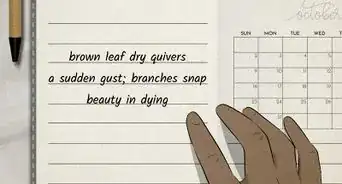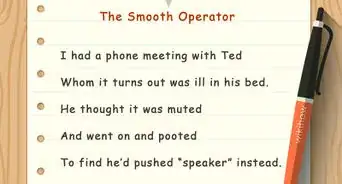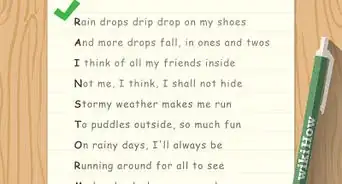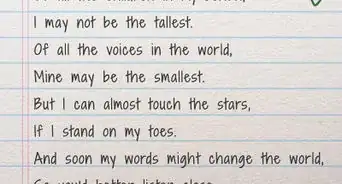This article was co-authored by Alicia Cook. Alicia Cook is a Professional Writer based in Newark, New Jersey. With over 12 years of experience, Alicia specializes in poetry and uses her platform to advocate for families affected by addiction and to fight for breaking the stigma against addiction and mental illness. She holds a BA in English and Journalism from Georgian Court University and an MBA from Saint Peter’s University. Alicia is a bestselling poet with Andrews McMeel Publishing and her work has been featured in numerous media outlets including the NY Post, CNN, USA Today, the HuffPost, the LA Times, American Songwriter Magazine, and Bustle. She was named by Teen Vogue as one of the 10 social media poets to know and her poetry mixtape, “Stuff I’ve Been Feeling Lately” was a finalist in the 2016 Goodreads Choice Awards.
This article has been viewed 49,072 times.
Death is an unavoidable part of life. If you've lost someone, you may be feeling a range of emotions. Writing a poem can help you process your feelings, pay tribute to the deceased, or even give you something to read at the service.
Steps
Collecting Your Thoughts
-
1Write everything you wish you could say. Writing out what you'd like to say to the person you've lost is a great way to gather your thoughts and process their death. As you collect your thoughts, you may want to write a list, a letter, or even an essay.
- Think about all the things you would tell that person. You might be feeling sad or angry, or you might recall happy memories and feel grateful.
- Write whatever comes to mind without filtering or revising your words.
- There's no right or wrong way to write out what you'd like to say. You can be totally honest since you don't have to show this part to anyone else.
-
2Identify your favorite words and phrases. Read through your notes, whether it's a list, a formal letter, or something else entirely. This is the raw material of your poem, and you'll need to mine these notes for the pieces that will make up your poem.
- Circle, underline, or highlight the words and phrases you choose.
- You may want to choose words based on the associations you've made in your mind, the relevance of those words to the deceased's life, or the poetic nature of those words.[1]
Advertisement -
3Come up with some strong imagery. As you review your favorite words and phrases, you should begin to visualize some strong images. Consider the sights, smells, sounds, tastes, and physical sensations that come to mind as you read through your favorite words and phrases.[2]
- Choose concrete words and phrases (which describe things using the senses) instead of abstract ones (which refer to feelings or concepts). Concrete words help the images take shape in the reader's mind.
- An example of an abstract description would be "the grass was tired." A concrete description would be something like "the blades of grass bent over, leaning for a lifetime against the prairie wind."
- Try to paint an image with your words. Think about abstract/original ways of phrasing things and vivid, descriptive phrases that capture the words you identified as your favorites from the earlier notes.
- One way to paint a picture with words is to try to describe the most striking images you see. For example, you might describe the deceased person's hands, then zoom out to what they're holding, then describe the way the deceased used to perform that action.
-
4Decide how you want to organize your thoughts. The ultimate shape you want your poem to take will influence how you organize your thoughts and begin drafting your poem. Now that you've put all your raw thoughts and feelings on paper and made imagistic phrases from your favorite words, you'll need to figure out how you envision your poem taking shape.
- Do you want your poem to capture a particular moment between you and the deceased? Or perhaps a general moment in the life of the deceased?
- Your poem could also capture a conversation you and the deceased had, or it could be a response to something the deceased said to you.
- You could use your poem to simply describe the characteristics of the deceased.
Writing a Poem
-
1Choose a poetic form. Before you begin actually writing your poem, you may want to consider what form you'd like the poem to take. There are many poetic forms, and no one form is necessarily better or worse than any other form. Which form you choose will depend on the aesthetic style that most appeals to you.[3] Common forms of poetry include, but are not limited to:
- abstract poetry - plays with different sounds and rhythms to evoke different emotions
- elegy - poem of mourning/sorrow
- haiku - Japanese poetic form that is restricted to three lines containing five syllables in the first line, seven syllables in the second line, and five syllables in the third line
- sonnet - 14 line poem written in iambic pentameter
- sestina - poetic form that plays with using six words rotated as the ending word of each line throughout the poem
-
2Begin the poem with your strongest image. Opening the poem with a vivid image will grab the attention of your audience and set the tone for the rest of your poem.[4] Think about which image or images are most important to you or most accurately capture the overall feeling or mode you hope to capture in the poem.[5]
- You can get a pretty good idea of your strongest image by identifying the one that always comes to mind when you reflect on your list.
- If you're not sure which image is your strongest, try asking a friend or relative which image stands out the most in your poem.
-
3Compose the main idea of your poem. Many strong poems have one line that encapsulates the rest of the poem. This key line may capture the feeling of the poem, or it could be a line that explicitly states what the poem is all about.[6]
- Consider what it is you're hoping to say about or to the deceased with this poem.
- Be creative. Obviously you miss the deceased, but how can you make your poem an interesting and unique tribute to that person?
- The main idea should involve the deceased, but it can be about any aspect of their life or even a realization you've had because of their passing.
-
4Rewrite any cliche phrasings. A cliche is a phrase that is highly overused and comes across as unoriginal or uncreative. Cliches can easily ruin an otherwise exquisite poem. As you read through your poem, try to identify any phrases that sound like a stereotypical poetic phrase (anything you feel like you've heard before a million times), then rewrite them.
- An example of a cliche would be, "The sun sets on his life."
- Identify what the cliched phrase is trying to say.
- Brainstorm original ways to convey that information. Try using metaphors (comparisons that don't use like or as) to strengthen the poetic nature of your writing.[7]
- Choose your favorite non-cliche description and see how it fits with the rest of the poem.
- A less-cliched version of the above line might be, "He could no longer keep up with the orbit of the hours."
-
5Pair back on sentimentality. While you are obviously dealing with a range of highly-sentimental thoughts and feelings, you want your poem to remain approachable to readers who may not share your memories of the deceased. Look back over your poem and try to identify places where you let your emotions take control of the poem, then try rewriting those sections with a more even tone.[8]
- An example of a sentimental line might be, "I miss him so much."
- Look for any sections of the poem in which sadness, grief, or anguish completely dominate the poem.
- Ask yourself whether a reader who does not share your memories could understand or relate to those parts of the poem.
- Try rewriting those sections in a more controlled, less-emotional tone.
- A less-sentimental way of saying the above line might be, "I carry a million memories and all of them are his."
Sharing Your Poem With Others
-
1Choose someone you can share your feelings with. If you're sharing your poem with someone for the first time, it may be easiest to choose someone with whom you feel comfortable. A friend or family member may be ideal, though you may also want to consider whether the individual you choose knew the deceased and can relate to how you're feeling.[9]
- Make sure the person you choose will not be judgmental or rude when you share your poem. Consider choosing someone close to you who will be understanding and supportive.
-
2Decide whether to read your poem or show it. Some people feel more comfortable reading out loud, while others may prefer showing a printed form of the poem to someone. There is no right or wrong choice regarding how you share your poem; it's simply a matter of what you're more comfortable with.
- Reading the poem out loud gives you the opportunity to voice the poem as you imagine it. You can use inflections and pauses to emphasize certain parts, which can't be done if someone is just reading the written words.
- Having someone else read the poem takes some of the pressure off of you to perform. You don't have to worry about tearing up or getting emotional while you read, but you lose the chance to voice the poem.
-
3Consider reading the poem at the service. If you were close to the individual who passed away, you may be asked to speak at his or her service (if a service is held). If you do decide to speak at the service, reading your poem could be a moving tribute to the person you've lost. However, your poem may be intensely personal, and you may not feel comfortable sharing it at the service. It's perfectly acceptable if you want to read your poem, but there's nothing wrong with preferring to keep it private - it's strictly a matter of personal preference and comfort.
Community Q&A
-
QuestionDoes my poem have to be a eulogy?
 Community AnswerNo, it doesn't have to be one.
Community AnswerNo, it doesn't have to be one.
Warnings
- You don't have to deal with grief alone. Try talking to a close friend or relative, call a telephone hotline, or seek counseling if you feel depressed.⧼thumbs_response⧽
Things You'll Need
- Paper and pen or a computer
References
- ↑ Alicia Cook. Professional Writer. Expert Interview. 11 December 2020.
- ↑ http://jerz.setonhill.edu/writing/creative1/poetry-writing-tips-how-to-write-a-poem/
- ↑ http://www.writersdigest.com/whats-new/list-of-50-poetic-forms-for-poets
- ↑ https://owl.english.purdue.edu/owl/resource/1000/01/
- ↑ https://www.psychologytoday.com/blog/the-empowerment-diary/201508/how-write-healing-poem
- ↑ https://owl.english.purdue.edu/owl/resource/1000/01/
- ↑ https://www.psychologytoday.com/blog/the-empowerment-diary/201508/how-write-healing-poem
- ↑ http://jerz.setonhill.edu/writing/creative1/poetry-writing-tips-how-to-write-a-poem/
- ↑ http://kidshealth.org/en/teens/someone-died.html#








































































